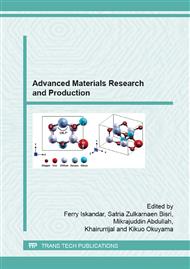p.303
p.308
p.313
p.317
p.323
p.329
p.333
p.338
p.345
The Improvement of Product Quality and Production Capacity of Metal Coin Dies by Tempering Treatment and PVD TiN Coating in IsodurTM Steel
Abstract:
In industry of coins production, dies is proportionally compared with the production of coin. Dies, one of the essential components, is externally influenced by geometry, relief, setting parameter production and others. While, internally dies will be affected by its physical property and surface treatment. Phenomenon of dimension deformation and poor wear resistance on dies surface, are part of leakage factor in coin production. In this research, the mechanical properties of IsodurTM steel is being controlled by heat treatment especially tempering treatment and TiN PVD coating with arc cathodic method, in order to produce coining dies. IsodurTM steel samples are heated until temperature 1080◦C in 30 minutes, then samples are quenched and has a single and double tempered treatment at temperature 550◦C in each. After that, samples are coating with TiN and have variables of PVD process holding time 6 and 12 minutes. The result show that hardness of single temper treatment is 62.9 HRC on temperature 550◦C is constant in IsodurTM steel. While the double tempering treatment will decrease the hardness becoming 61.49 HRC and it will make the microstructure being finer than single tempering treatment. The variables of holding time PVD 6 and 12 minutes do not influence the roughness surface relief of coining dies, but they affect the wear resistance that is showed in average capacity production about 251,552 and 262,403 coin per dies by single tempered treatment, and average capacity production about 355,625 and 359,243 coin per dies by double tempered treatment.
Info:
Periodical:
Pages:
323-328
Citation:
Online since:
July 2015
Keywords:
Price:
Сopyright:
© 2015 Trans Tech Publications Ltd. All Rights Reserved
Share:
Citation:


